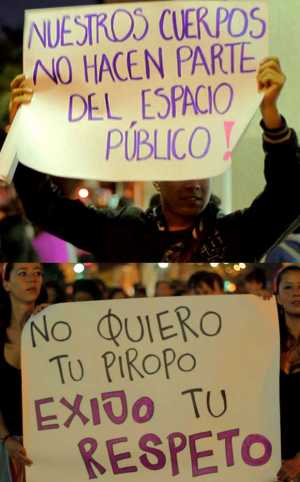From a very young age, women face situations of harassment of women in the streets and in public or private spaces. Moreover, many people have accepted this as a given, and for some reason, this problem was never properly confronted.
The Landscape is Changing
However, since the early 2000s, more and more groups have emerged willing to fight against the harassment of women.

Currently, Peru, Chile, Colombia, and Brazil already have initiatives calling for an end to catcalling and sexual harassment in public spaces.
The OCOC (Observatory Against Street Harassment) was created with the support of groups from Peru and Chile. The team consists of a sociologist, an educator, a psychologist, a philosopher, a social worker, and a film and television director.
Consequently, the goal of OCOC is to hold discussions in public spaces to explain how harassment of women in the streets constitutes a form of violence.
Speaking Out Loud About Harassment
Furthermore, street harassment affects the majority of women at some point in their lives. Therefore, in order to address this problem, we must speak up, set fear aside, work together, and take action. As a result, it is time to dismantle this issue.
If you have to walk near a construction site, you might be told to hunch your back, mess up your hair, or try to look as unattractive as possible—because, supposedly, that is the only way they won’t say anything.
In addition, street harassment usually begins when women are young. Most women—and some men—will face it. Why? Harassers believe they have the right to do so, but this could not be further from the truth. Indeed, harassment of women limits people. It is a form of gender-based violence and must stop.
Why should we tolerate unwanted comments, gestures, and actions? Clearly, these behaviors highlight power dynamics between genders.
Harassers and aggressors disrespect their victims by intimidating them, evaluating them with leers, making sexual demands, following them, and even touching them. And yes, in extreme cases, assaulting and killing them.

Street Harassment
Although the existence of street harassment may be “new” to many men who read or hear about it, it is certainly not new for women. Unfortunately, for generations, grandmothers, mothers, aunts, and older sisters have advised girls on how to try to stay safe.

However, it is time to move beyond this well-intentioned advice, which often makes women feel less safe and frequently does not work.
Street harassment happens on nearly every corner, and such advice limits women’s access to public spaces. In reality, women are on guard, avoiding the streets, and dependent on men as escorts.
Ultimately, no country has ever achieved equality, and women cannot walk without fear of harassment of women anywhere in the world.
These are the sad truths. And as a woman, I ask: why must we depend on a man to feel safe? Why must we cover ourselves to feel safe? Why do I have to pretend it doesn’t matter?
Moreover, street harassment includes unwanted whistles, lewd and sexist looks, slurs against homosexuals and transgender people, persistent requests, sexual names, comments, following, flashing, public masturbation, sexual assault, and rape.
Steps Toward Change
Let me be absolutely clear: harassment of women is not a compliment or a flirtatious comment. It is not a minor nuisance and, most importantly, it is never the woman’s (or victim’s) fault. Recognizing this is crucial, because ignorance or a sense of power does not give anyone the right to treat a person as an object or property.
It is predatory behavior—as if women were prey or prizes. More often than believed, teenage girls and young women hear these repulsive and grotesque comments. I can only imagine that anyone who says such words with ill intent assumes the girls are too young to know how to respond. Sadly, the harassers are not wrong.
My Body, My Rules, My Decision. – Laura Viera A –-
The best and only way to counter these attacks is through the empowerment of girls and women everywhere. This includes teaching self-defense tactics, assertive responses, and how to report harassers. Because, as we all know, ignoring and avoiding harassers changes nothing.
In addition, another way to help is to focus on individuals who may, over time, become harassers. We must stop looking the other way or saying, “Boys will be boys.” Consequently, I ask myself: how would a harasser react if someone treated his mother, girlfriend, or daughter in this way?

Let me be clear: a person has the right to access pornography or fantasies in any situation they choose, but they do not have the right to bring those fantasies into the streets and act as if our bodies belong to them.
Over time, things will change—I know they will. Thanks to organizations like the Observatorio Contra el Acoso Callejero (Colombia), people are beginning to confront this issue.
Therefore, we must change a society that allows the harassment of women. Our task is simple: challenge all comments, attitudes in the media, and policies that disrespect and discriminate against women.
In conclusion, we must challenge all violence, provocation, and gender-based harassment; everything is connected.
Men run around shirtless all the time, and nobody yells sexual comments at them! If you haven’t noticed, it is probably because you have the privilege of not being harassed on the street. If, you care about the current and next generation of girls, if you support equality, if you believe in human decency, then you cannot stand idly by. You must act. Indeed, harassment is about power and control and is often a manifestation of social discrimination.


